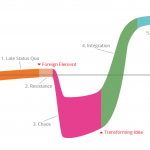There’s this musical challenge called the #TwinkleTwinkleLittleStarChallenge which is trending right now.
It was kicked off on Instagram by the American Gospel musician Bart Orr and asks for musicians around the world to share their own versions of this classic song. And as viral things go (recall Why this Kolaveri Dee?!) this challenge took off in no time and has become hugely popular. From 7 to 70 year old, from all corners of the world, there have been tons of recordings that keep getting posted. To get a sense of it just go to Youtube and type #TwinkleTwinkleLittleStarChallenge and you can see them.
But things just got downright mind-blowing when double Grammy Awards winner Jacob Collier decided to take on the challenge himself.
While most of us hear a piece of music after it is composed, recorded, and edited multiple times, we rarely get to see music being born right in front of our eyes. Jacob Collier decided to demonstrate that with a live audience over a long session that lasted several hours.
The full stream of the entire session is available here:
Before we see the final version, let’s see what made this session so fascinating for everyone who watched. Including Bart Orr who posted the challenge who could not believe what was witnessing and posted this message:
“God we didn’t know you made @jcolliermusic to be this GENIUS…. We really didn’t know”
Here are the salient features you can jump to if you want a quick “bite”. This is like going into an ice-cream shop and quickly getting a taste of their most popular flavors in a few minutes!
- Jacob paints you an aural landscape composed of sprinkles (19:50)
- And diamonds (1:36:17)
- And rainbows (2:25:35),
- And even Big Ben (41:44) (all acting here as metaphors for their real counterparts)
- While making ultra high level techniques such as microtonal runs (43:05) (e.g. he divides a descending C to A run into four steps instead of three)
- And sum tones (1:44:52) (e.g. giving the illusion that a note is there through the combination of other notes in the harmonic series) sound just natural. Truly fascinating!
The final output he posted here:
The result is a fascinating deep dive into the mind of a genius composer who not only shares his thought process but also his wizardry with the technical tools that he uses like a magic wand to summon the sounds he is thinking of.
So how does one go about making a new version of a song? While we can’t all be like Jacob and do crazy re-harmonizations we can try some simple things.
Every song has three parts to it: melody, harmony and rhythm. So to create a variation you can:
- Keep the melody and re-harmonize (choose a different set of chords that also work for the melody) or
- Keep the notes of the melody but introduce variations in rhythm or
- Keep the melody but change the *rhythm of the harmony* (which gives a different “texture” to the song)
Let’s see how you use this idea with the Twinkle Twinkle song. The original version of Twinkle Twinkle is set to C major and 2/4 meter . But instead of playing the notes as straight sixteenth you can try to give it a triplet feel (maybe with a swing even to give it a jazzy touch!) as shown below (this is btw one of Mozart’s 12 variations for the song!):

(Source: http://www.cengage.com/resource_uploads/downloads/049518974X_78467.pdf)
Or you can simply switch the scale to say C minor (Mozart’s Variation 8), play it on a metal guitar and give it a grunge-rock feel!
Try different ways and have fun with your creativity!
Download the Manoke App to help you practice until you make perfect!






